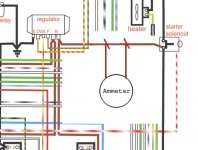tahoe healey
Yoda
Offline
In Norm Nocks book, Tech Talk, the instruction about installing an amp meter indicates connection to terminal "A" on the regulator. I got all kings of alphabet but no "A". What gives? I haven't found anything specific in the archives.

 Hi Guest!
Hi Guest!

 smilie in place of the real @
smilie in place of the real @
 Pretty Please - add it to our Events forum(s) and add to the calendar! >>
Pretty Please - add it to our Events forum(s) and add to the calendar! >> 
